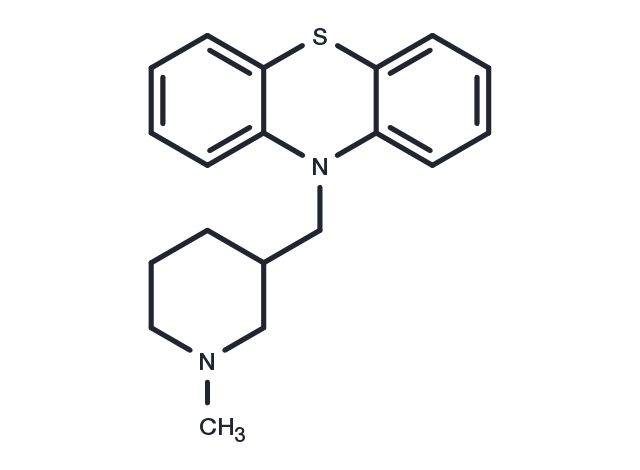Powder: -20°C for 3 years | In solvent: -80°C for 1 year


Mepazine (Pecazine) is a potent and selective inhibitor of MALT1. Mepazine inhibits GSTMALT1 full length and GSTMALT1 325-760 with IC50s of 0.83 μM and 0.42 μM. Mepazine enhances apoptosis and affects the cell viability.

| Pack Size | Availability | Price/USD | Quantity |
|---|---|---|---|
| 5 mg | In stock | $ 39.00 | |
| 10 mg | In stock | $ 56.00 | |
| 25 mg | In stock | $ 93.00 | |
| 50 mg | In stock | $ 143.00 | |
| 100 mg | In stock | $ 198.00 | |
| 200 mg | In stock | $ 312.00 | |
| 500 mg | In stock | $ 526.00 | |
| 1 mL * 10 mM (in DMSO) | In stock | $ 48.00 |


| Description | Mepazine (Pecazine) is a potent and selective inhibitor of MALT1. Mepazine inhibits GSTMALT1 full length and GSTMALT1 325-760 with IC50s of 0.83 μM and 0.42 μM. Mepazine enhances apoptosis and affects the cell viability. |
| In vitro | Mepazine (5, 10, and 20 μM) decreases cell viability in the ABC-DLBCL cells HBL1, OCI-Ly3, U2932, and TMD8, without significantly affecting GCB-DLBCL cells[1]. |
| In vivo | In female NSG mice with a murine DLBCL xenogeneic tumor model, Mepazine (16 mg/kg; i.p.) interferes with the growth and induces apoptosis of ABC-DLBCL cell line OCI-Ly10. Mepazine strongly impairs the expansion of OCI-Ly10 with daily administration[1]. |
| Synonyms | Pecazine |
| Molecular Weight | 310.46 |
| Formula | C19H22N2S |
| CAS No. | 60-89-9 |
Powder: -20°C for 3 years | In solvent: -80°C for 1 year
DMSO: 25 mg/mL (80.53 mM)
You can also refer to dose conversion for different animals. More
bottom
Please see Inhibitor Handling Instructions for more frequently ask questions. Topics include: how to prepare stock solutions, how to store products, and cautions on cell-based assays & animal experiments, etc.
Mepazine 60-89-9 Apoptosis Immunology/Inflammation MALT diffuse B cell inhibit large mucosa associated lymphoid tissue lymphoma translocation gene 1 MALT1 lymphoma ABC-DLBCL Pecazine Inhibitor inhibitor
